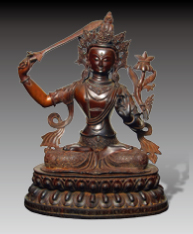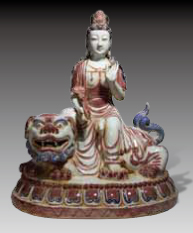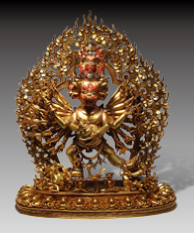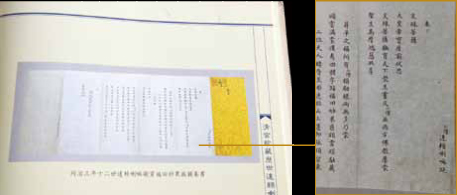Manjusri is believed to be the most ancient Bodhisattva,
according to the The Astasahasrika Prajnaparamita Sutra,
Manjusri appeared together with Maitreya,
which was earlier than Avalokitesvara.
Mercy, wisdom and power are the three core learnings of Tibetan Buddhism, representing the ultimate goal for us to accomplish Buddhahood in our present life. Manjusri, or “Bodhisattva Manjusri” in Sanskrit, is a symbol of wisdom denoting “living being who has the intrinsic nature of insight”. It refers to those who are audacious in pursuing enlightenment. Manjusri is pronounced as “Wen Shu Shi Li” or “Man Shu Shi Li” in Chinese and “Jampelyang” in Tibetan, meaning “wonderful and auspicious”. Manjusri is regarded as “the wonderful virtue” in Chinese Buddhism. He is believed to be the most ancient Bodhisattva. According to The Astasahasrika Prajnaparamita Sutra, Manjusri appeared together with Maitreya, which was earlier than Avalokitesvara. He had already attained Buddhahood in his past life, but with a merciful heart and a mission to guide mankind away from confusion and to embrace true wisdom, he appeared in the Saha World with an ever-youthful, bold and determined image.
 |
|
A traditional image of Manjusri
in Tibetan Buddhism, adorned
with a precious crown while
holding a sword of wisdom and
a lotus. |
|
The Master of all Buddhas, the Mother of all Buddhas
Manjusri, also named as “Great Wisdom Manjusri Bodhisattva” for his sagaciousness and dexterity, is regarded as “the Master of all Buddhas” and “the Mother of all Buddhas”, as well as the head disciple of Sakyamuni. Manjusri, with his supreme wisdom that is close to the wisdom of Sakyamuni, has been recognized as the most suitable candidate to inherit the position of the Buddha. Thus, he is also named as “The Son of the Dharma-king”. Assisting Sakyamuni in edifying mankind, Manjusri and Samantabhadra are often paired together as attendants on either side of Sakyamuni. The three of them are thus known as “The Three Sages of Huayan”. With his power, reputation and eminency in Mahayana Buddhism, Manjusri is also listed as one of The Four Great Bodhisattvas and The Eight Great Bodhisattvas. The Four Great Bodhisattvas are Avalokitesvara, Manjusri, Ksitigarbha and Samantabhadra, who signify the four virtues, “Mercy”, “Wisdom”, “Vows” and “Conduct” respectively. Among all, Manjusri, who has experienced and overcome misfortune, is particularly good at preaching vast wisdom, which leads him to become the head of The Four Great Bodhisattvas. Of the Four Great Sacred Buddhist Mountains in China, Mount Wutai in Shanxi Province was the Dharma centre of Manjusri; Mount Putuo in Zhejiang Province was where Avalokitesvara lived; Mount Jiuhua in Anhui was the dwelling place of Ksitigarbha and Mount Emei in Sichuan was the sanctum of Samantabhadra. In June 2009, Mount Wutai was inscribed on UNESCO's World Heritage List as a cultural landscape.
The Four Great Bodhisattvas are Avalokitesvara, Manjusri,
Ksitigarbha and Samantabhadra, who signify the four virtues,
“Mercy”, “Wisdom”, “Vows” and “Conduct” respectively.
The Return of the Merciful Manjusri, the Master of Sakyamuni
How could Manjusri be the master of Sakyamuni? According to The Suramgama Sutra, Manjusri had already accomplished Buddhahood in his past life and had been granted the name “The Buddha of the Race of Honourable Dragon Kings”, the Buddha of the Dragon Realm. However, driven by his passion to benefit and enlighten sentient beings, Manjusri decided to return to earthy life as a Bodhisattva. As quoted in The Ajatasatrukaukrtyavinodana Sutra, Sakyamuni said “Today I have become a Buddha, with 32 physical marks and 80 notable physical characteristics. I possess esteemed greatness and I am able to enlighten others, all because of the kindness of Manjusri, who is my teacher. Many Buddhas are followers of Manjusri, and Manjusri is the reason why they have been able to accomplish Buddhahood. Manjusri to Buddhas is just like parent to children – Manjusri is the parent of Buddhas.” Sakyamuni's words, which thoroughly interpreted Manjusri's mercy and kindness, have proven the status of Manjusri as “the Master of all Buddhas”, “the Mother of all Buddhas” as well as the teacher of Sakyamuni.
“Today I have become a Buddha…all because of the kindness
of Manjusri, who is my teacher. Many Buddhas are followers of
Manjusri, and Manjusri is the reason why they have been able to
accomplish Buddhahood…Manjusri is the parent of Buddhas.”
The Ajatasatrukaukrtyavinodana Sutra
Footsteps all around the World
The preaching of Manjusri can be traced back to the 1st century of the Christian era, when Mahayana Buddhism emerged in India. In the 2nd century, the doctrine was propagated in China via The Silk Road and has exerted significant influence in the country for almost 2,000 years. Manjusri's teachings were very popular and Manjusri was honoured by emperors as the protector of the nation. It was introduced to China and became popular well before those of Avalokitesvara. It is obvious that Manjusri possesses the same popularity as Avalokitesvara in various aspects, whether for scriptures or the presentation of statues, etc. Subsequently, Manjusri's teachings reached as far as Korea, Japan, Mongolia and different areas in East Asia. In the 7th century, Songtsan Gampo, the founder of Tibetan Empire, facilitated the economic and cultural exchange with the neighbouring countries with political marriage. Princess Bhrikuti from Nepal and Princess Wencheng from the Tang Dynasty brought Buddhism to Tibet. In 763 A.D., Trisong Detsen invited Padmasambhava to Tibet to further spread Buddhism and built a solid foundation for Tibetan Buddhism. In the 8th century, Vajrayana was brought to Tibet from India and that was the first time when the Tibetans were able to see respectfully the sacred appearance of Manjusri, who then became the most important Yidam of Tibetan Buddhism. Manjusri, together with Avalokitesvara who symbolizes mercy, and Vajrapani who represents power, are known as “The Lord of the Three Families”.
The Presentation and Image of Manjusri Manifests Celestial Significance
Manjusri appears in many different images, while “Manjusri of the Five Locks” is the most common one. The five locks symbolize five kinds of Buddhist wisdom. Dushun Monk, the founder of Huayan zong in the Sui and Tang Dynasty, was also regarded as one of the incarnations of Manjusri. To facilitate the preaching, Manjusri often holds a sword in his right hand, which helps to eliminate ignorance and delusion, stupidity, greed, obsession and afflictions of the people. Sometimes he holds a lotus on top of which lies The Heart Sutra. The lotus symbolizes purity and The Heart Sutra manifests wisdom and compassion. Manjusri always rides on a lion, which signifies wisdom, courage and power, or sits on a lotus pedestal, which signifies purity.
Manjusri often holds a sword in his hand,
which helps to eliminate ignorance and delusion,
stupidity, greed, obsession and afflictions of the people.
 |
|
A Chinese Manjusri statue does
not carry a sword and usually rides
on a lion. |
|
 |
|
Vajrabhairava, a wrathful
incarnation of Manjusri. |
|
When Cultures Meet and Generate Wonders
Buddhism made its entry into China in the 2nd century A.D., and subsequently spread to other parts of East Asia. Through interacting with various cultures, Manjusri statues embrace various and different characteristics. The Chinese Manjusri images, belonging to Exoteric Buddhism, are usually Bodhisattva or Bhiksu. Bodhisattva is more glamorous whereas Bhiksu is subtle and unpretentious. A Chinese Manjusri statue does not carry a sword and usually rides on a lion. Tibetan Buddhism started to flourish in the 7th century and Tibetan Manjusri statues usually look more elegant, with a slender and well-curved figure, and dressed more sumptuously with magnificent crowns, jewelled ornaments and so on. A Tibetan Manjusri carries a sword of wisdom and a lotus, sitting peacefully on a lotus pedestal, some statues may carry a bow and an arrow, or a bell and Vajra. Manjusri statues in Esoteric Buddhism appear in stronger images as he bears the mission to reduce hatred, resentment and negative thoughts. Vajrabhairava is the revelation of a wrathful incarnation of Manjusri.
The Birth of the Legend, the Rise of the Religion
The Manjusri Parinirvana Sutra tells the story of the birth of Manjusri. Manjusri was born in a Brahmin family in Sravasti in India. Legend has it that he was born from the right underarm of his mother. Upon birth in a purplish golden colour, he could actually talk, with seven treasures covering him. He also brought with him numerous auspicious physical marks. He was known as “wonderful and auspicious” because a total of ten auspicious signs appeared in his home when he was born. These included bright light in his house, emergence of seven jewels from the earth, chicken gave birth to phoenixes…, and the 10th symbol was the growth of six tusks on an elephant. It was quoted from The Samantabhadra Bodhisattva Dhyana Carya Dharma Sutra: “Six tusks symbolize the six stages to reach Buddhahood, and four legs represent the four kinds of luck.” The six stages in Buddhism are to give, to maintain self-disciplines, to overcome humiliation, to enhance oneself, to meditate and to achieve the highest wisdom. Apart from that, the purity, kindness, diligence and assiduity of an elephant also signify the merciful acts of Bodhisattva. When Manjusri grew up, he became a monk to explore and practise Buddhism with Sakyamuni. 450 years after the death of Sakyamuni, Manjusri carried on his preaching on a snowy mountain. Subsequently, he gained enlightenment under a Nyagrodha tree.
“Six tusks symbolize the six stages to reach Buddhahood,
and four legs represent the four kinds of luck.”
The Samantabhadra Bodhisattva Dhyana Carya Dharma Sutra
The Chinese Manjusri, the Protector of the Nation
Following the propagation of Buddhism in China, emperors had a special respect and sentiment for Manjusri throughout history. Apart from the special connection that the imperial families established with Manjusri, many of them regarded Manjusri as the protector of the nation. It is recorded that Li Yuan, the Emperor Gaozu of the Tang Dynasty, after his seizing of sovereignty, had built magnificent temples for Manjusri in Mount Wutai in Taiyuan. These temples in Mount Wutai not only enhanced the Manjusri's teachings but also established Manjusri's image as the protector of his reign. In the 7th century, Empress Wu Zetian, after having taken over the reign, also tried to use the authoritative Buddhist scriptures and Manjusri's nation protecting image to reinforce her status. In the Qing Dynasty, Emperor Qianlong was regarded as an incarnation of Manjusri: he tried to reinforce his reputation in Mongolia and Tibet, hoping that the people in these territories would respect him as much as they honoured Manjusri.
To Harmonize Thoughts and Move on to Pantisocracy
Throughout thousands of years of Chinese history, Confucianism has always been the core and the most significant philosophy in the cultural development in China in managing the country, whereas Taoism is also a wide-spread and popular doctrine. When Buddhism was first spread to China, the clash with the other two schools of thoughts had generated certain contradictions, even conflicts. Fortunately, the three schools of thoughts were eventually harmonized and by complementing one another, they evolved into a new version of Buddhism with Chinese characteristics. Manjusri had played an important role in the process of evolution. In China, Confucianism was the foundation of the royal reign. The manner in which the emperors worshipped Manjusri, the vast promotion of his teachings, the building of temples, the creation of statues and images, the designation of Mount Wutai as the base of Manjusri, etc., all led to the enhancement of Manjusri's teachings. The growing popularity and the increasing social recognition of Buddhism had evidenced the harmonization of the three schools of thoughts. As quoted in Chapter 14 of The Lotus Sutra: “One should not discuss about others. One should not think negatively of others. Not in words, not even in mind.” The teaching illustrates the emphasis of harmony in Buddhism, leading to the assimilation of different schools of thoughts in religion and philosophy.
“One should not discuss about others.
One should not think negatively of others.
Not in words, not even in mind.”
The Lotus Sutra
Manjusri and Samantabhadra Shine at Dunhuang
The Sui and Tang Dynasty marked the golden age of Buddhism in China. Among the Four Great Bodhisattvas, Avalokitesvara and Ksitigarbha were well-known for their mercy. The nobles and government officials, as well as the intellectuals from the upper class, however, appreciated the wisdom of Manjusri and the virtue of Samantabhadra. With the enhancement of The Avatamsaka Sutra, which emphasized the integration of wisdom and virtue, the superior status of Manjusri and Samantabhadra at the time was revealed in the art of Dunhuang along The Silk Road.
The images of Manjusri and Samantabhadra appeared in a lot of paintings in the Mogao Caves in Dunhuang, which were created in the Tang Dynasty. Out of all caves in China, one can find the largest quantity of “Transformation of Manjusri” and “Transformation of Samantabhadra” in the Mogao Caves, with the “Transformation of Manjusri and Samantabhadra” in Cave 3 of Yulin Grottoes being recognized as the classic. In the painting, Manjusri sits on a lion while Samantabhadra rides on an elephant, and they are surrounded by numerous Bodhisattvas and celestials, dressed elegantly. The painting was completed in Chinese ink painting technique, and it bears a refreshing style, which differs from the usual Buddhist style which uses a lot of shiny, golden colours. The grand presentation of the scenery, with mountains and rivers, green pastures and human characters, is illustrated in a rather Taoist manner, which is very impressive. Yulin Grottoes was built in the time of Xi Xia, during the Southern Song Dynasty, when water ink became popular, especially in royal paintings. At the same time, Taoist celestials started to appear in art and paintings of Dunhuang. The painting evidenced the integration of the cultures of Xi Xia and Central China as well as the implementation of Taoist elements in Buddhist art. Taoists also named Manjusri as “Sky Master of Widespread Teaching” and Samantabhadra as “Pu Xian Taoist Master” respectively. This also constitutes another proof of the assimilation of Buddhism and Taoism at the time.
The Emperors, the Incarnations of Manjusri
Tibetan Buddhism arrived in Tibet during the reign of Songtsan Gampo in the 7th century A.D., but it was Trisong Detsen, the 37th Emperor of Tibet, who invited Padmasambhava to preach in Tibet and reinforced the development of Buddhism in Tibet. As the Tibetans learnt more about Manjusri, his status became more and more sublime. The emperors and outstanding leaders in Tibet were regarded as the incarnations of Manjusri. Apart from the very brilliant and virtuous Trisong Detsuen who was regarded as reincarnated Manjusri, Pandit of Sakya, Longchen Rabjampa of Rnying-ma-pa, Tsong-kha-pa of Dge-lugs-pa were respected as masters with profound wisdom. Possessing the distinguished characteristics of Manjusri, the three masters have been regarded as his incarnations subsequently.
 |
|
The attached picture denotes the statement delivered by the 12th Dalai Lama
in 1864 for expressing his gratitude and bliss as well as thanking Emperor Tongzhi
of the Qing Dynasty for bestowing a tablet. The wordings of “Futian Miaoguo” in
Chinese, with the meaning of “blessing field of wonderful fruit”, were personally
written by Emperor Tongzhi on the tablet, which is still hanging in front of the
Avalokitesvara Hall of the Potala Palace today. The 12th Dalai Lama also called
Emperor Tongzhi as “Manjusri” in the statement.1
|
|
The Relationship Between Manchu and Manjusri Historians and scholars who study the history of the Qing Dynasty believe that Manchu is closely related to Manjusri. Since Emperor Shunzhi, Tibetan lamas had been calling the Qing emperors as “The Great Manjusri King”. As early as in the Sui and Tang Dynasty, many different ethnic groups had been deeply influenced by Buddhist teachings. Manjusri was respected as the master of all Buddhas. Given the similar pronunciations of “Manchu” and “Manjusri”, “Manjusri” was not only the name of Bodhisattva, but also the designation of the leader of a race, a tribe, even a nation. “Manchu” was originated and descended from Jurchen. In the 17th century, when the Qing Emperor Huang Taiji took over the reign of the Central China and renamed his dynasty to “Da Qing”, “Manchu” was used as the official name of the tribe. With a similar name of “Manchu” and “Manjusri”, the Qing emperors were addressed “Manjusri” or “The Great Manjusri King” in all Tibetan statements or letters delivered to the Qing emperors since the 5th generation of Dalai Lama, “Manchu” is therefore not only the name of a tribe, it also reveals the close associations of its people to Tibetan Buddhism.
The Renowned Sacred Land of Manjusri
Mount Wutai was inscribed on UNESCO's World Heritage List as a cultural
landscape in June 2009. With plenty of worshippers and followers visiting
the sacred mountain, it is hoped that the Manjusri's teachings will be widely
spread, thereby attaining world peace and harmony.
Mount Wutai, one of the Four Great Sacred Buddhist Mountains in China, is also known as “The Cool Mountain”. In a range of five encircling flat-topped mountains, it is situated in the north-eastern Wutai county of Shanxi province. With a magnificent appearance, Mount Wutai bears the temperament of purity and power. It is well-known as the dwelling place of Manjusri. The five flat-topped mountains symbolize the five kinds of Buddhist wisdom. As described in The Avatamsaka Sutra, Manjusri and other Bodhisattvas with their followers did a lot of Buddhist teachings on “The Cool Mountain”, the location and climate of which matched exactly with Mount Wutai. Over the years, numerous emperors had contributed to the enhancement of the status of Mount Wutai. For example in the Eastern Han Dynasty, two monks from the Western Region recognized Mount Wutai as Vulture Peak Mountain, the preaching place of Sakyamuni, and successfully convinced Emperor Ming to build Dafulinjiu Temple. Since then, Mount Wutai has been regarded as the sacred land of Buddha. The worship of Manjusri was further enhanced in the Tang Dynasty. Both Emperor Li Yuan and Empress Wu Zetian regarded Manjusri as the protector of the nation, and Mount Wutai became even more reputable. The improving transportation had attracted numerous pilgrims from Mongolia, Tibet, Japan, Korea and India, which in turn facilitated the propagation of Manjusri's teachings. The sacred Buddhist Mount Wutai was inscribed on UNESCO's World Heritage List as a cultural landscape in June 2009. With plenty of worshippers and followers visiting the sacred mountain, it is hoped that the Manjusri's teachings will be widely spread, thereby attaining world peace and harmony.
CWCHF Research Team
Notes:The First Archives of Chinese History (2002). Treasure Collection of Dalai Lama From the Archives of Qing Dynasty. p.12. |
